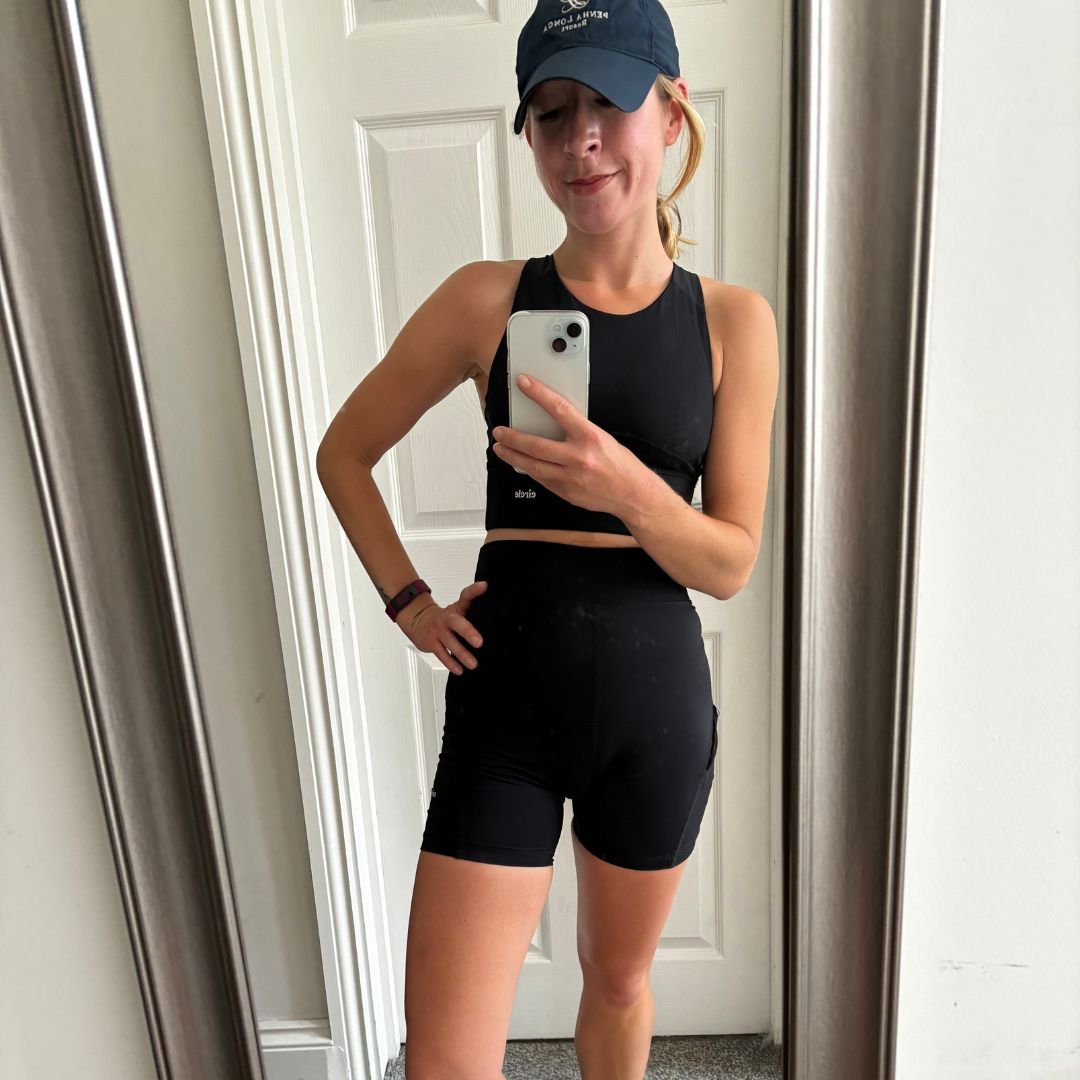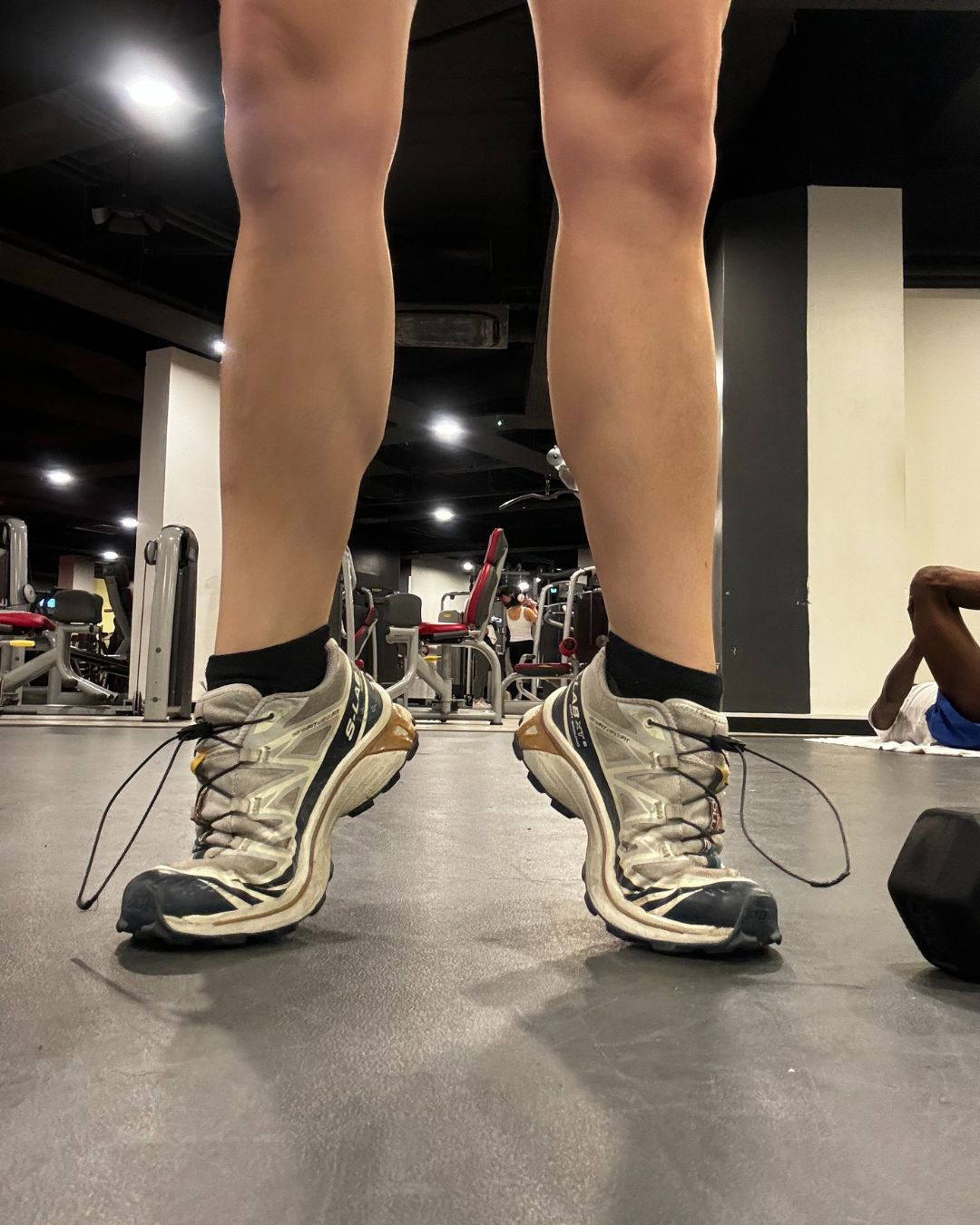
A little fitness challenge always gives me motivation, so earlier this month, I started looking for a move that would be super simple to add to my weekly workouts and effective, too. Enter stage right: this five-minute workout addition that promises to improve both balance and muscle.
A bit of background, before I get into the details. I gym a little bit but prefer cardio like swimming, running, and cycling - I enjoy workouts in the great outdoors the most, but know to do these, I need to strength train a little to injury-proof my body. The thought of heading to the gym was daunting for me (and not something I particularly wanted to do), so I opted for an equipment-free and easy-to-do-anywhere move that promised to boost strength and muscle.
I used to do ballet - it's one of the most joyful types of movement in my opinion (and another MC UK Health Writer agreed when she tried a ballet challenge recently). It's also a really effective way of toning your muscles and building strength, one of the many reasons why Barre classes are so popular.
So, throwing it back to when rélevés were a part of my day-to-day, I decided to give them a go for a week in addition to my other workouts. Bottom line: they were a simple, effective, and enjoyable workout addition that I'll likely be continuing, but for more on my little home workout challenge, keep scrolling. Keen to read a full Barre review, while you're here? You're in the right place.
I tried this five minute workout addition for a week and my lower legs have never felt better
What is an élevé?
Élevés are a common ballet move that require constant but stable movement. As Annie Landry, a former professional dancer turned dance teacher, PT, fitness instructor and corrective exercise specialist, explains, they're similar to calf raises explains.
You might have stumbled across the French word élevé from the verb élever which means to raise. This movement involves lifting from a first position or second onto the balls of your feet or into full pointe (depending on how advanced you are, and on what shoes you’re wearing).
Very similar sounding to élevé is the rélevé that stems from rélever which means to get up. In ballet terms, if you were to do a rélevé, you'd actually be starting with a bend in the knee, otherwise known as a plie.
@olegballet ♬ оригинальный звук - Olegballet
What is the correct form of an élevé?
To get the form bang on for an élevé, Landry advises starting with your feet in a parallel position slightly turned out (around 45 degrees) This is known as a first position in ballet and shouldn’t feel uncomfortable, but of course, do modify your position if you feel any tightness or stiffness in your knees, hips, or other areas.
“Remember to lift your lower abdominals and close off your ribcage," recommends Landry. This allows the tailbone to point straight down to the floor, she goes on, eliminating the natural curve in your spine while in turnout. “Plus, this will engage your core muscles and keep your spine in a safe position throughout the exercise."
Got it? Then, you'll want to:
- Lift up from your quads
- Slowly transfer your weight up and into the balls of your feet, micro-adjusting for balance
- As you press onto the balls of the feet, try to ensure that your ankle stays strong and that you do not allow it to roll back over the little toe. Keep the weight over the inside of the ball of the foot.
- Gently bring your heels down into your starting position. Then, repeat.
What is the élevé challenge?
In short, a less-than-five-minute daily series of élevés in first position. I followed Landry’s recommendation with a slight increase, as someone with prior experience of the move. I started with two sets of ten reps, aiming to progress to three sets of 10 reps, with an ultimate goal of three sets of 15 reps in each position by the end of the week.
So, what's so great about the move? In short, it's a great all-rounder and works multiple muscle groups. "Working in turnout will allow you to target the outside of your legs in addition to your calf muscles," Landry goes on. But do remember: "There's no need to force your turnout, simply open your toes outward from a parallel position and let them fall where they do naturally (which is generally around 45 degrees)."
@mackenziedaviz ♬ Candy Girl - Parov Stelar
3 benefits of élevés
1. Stronger calves = less likelihood of lower leg injury
Dancers, runners and all gym goers are more susceptible to ankle sprains, plantar fasciitis and other problematic injuries than, say, cardio-lovers. Improving the strength in your calves is a great way of helping you future-proof your body from ankle injuries, shares Landry, not to mention strengthen your gastrocnemius and soleus muscles (aka leg muscles).
Case in point: one 2020 article published by the Australian Ballet shared how single leg élevés following a morning barre class led to a “drastic reduction in lower-leg injuries.”
2. They challenge your core and target the entire leg too
The same study also found that élevés can help with proprioception - in other words, your awareness of your body in space. That's because the position tests your balance and stability, which helps with toning, too.
Great news, too: “You should experience results pretty quickly," encourages the trainer.
3. It is low-impact
Last but by no means least, another key benefit of élevés is the fact they strengthen your muscles without including any high impact jumping or movement that might put strain on your joints.
Low impact strength training is one of the best ways to boost full body strength, and they fall neatly into that category.
I tried a five minute workout addition in the form of an élevé challenge - how it went
As a 34-year-old Health Writer who regularly exercises but rarely picks up weights, I was keen to give a no equipment strength challenge a go.
I used to do ballet, and now run, cycle and swim quite a lot, so while I'm fit and healthy, there's always room for more tone, strength, and length.
Days one to three
Rather than go all in, I decided to gradually add on reps and movements with my calf-strengthening routine and élevés. As Landry advised me, I started by trying two sets of ten reps in each position, gradually working my way up to two sets of 15 reps later in the week.
Standing in my living room and moving my feet into first position (aka, your feet together then turned out at 45 degrees from the heel), it felt good to be back doing a move I'd practised so much in my younger years.
While traditional ballerinas will do these at a Ballet barre, I simply used the back of a chair in my home. One of my initial thoughts was how simple it is to incorporate the move into your day-to-day, as you really can use anything for stability, even completing your five minutes outside, if you wish.
Days three to five
By the middle of the week and my workout challenge, I'm loving my new routine. On day three, I add the élevés in after a yoga glass, and on day four, I complete my challenge after a 7km run.
While I was conscious that my legs might feel too tired, I actually found they felt strong and fuelled up (perhaps thanks to the muscle memory of my past ballet muscles). At this point, to take the challenge up another level, I added in single-leg élevés in turnout for three lots of 15 reps. I found that I could feel my muscles working a lot more in this position, especially in my side leg, which was super satisfying.

Days five to seven
Come the end of the week, I continued with both parallel élevés in first position and single-leg raises, using the wall for support. While the moves still felt challenging, it felt challenging in a good way, and my legs definitely felt stronger come the end of the week, despite only doing the challenge for seven days.
That said, I did notice that focusing on your form and engaging your core is essential for maintaining balance, challenging the right areas and keeping your ankles safe, too.
The conclusion
Honestly, this was a great mini-fitness challenge and I loved every second of it.
It felt like I was adding a micro toning move into my day and I loved that it gave me a greater awareness of both my self and my strength. Not just that, but I genuinely believe that I've seen and felt the benefits already (although I'll have to continue the move for at least another three weeks to confirm this).
As someone who finds it quite easy to roll my ankles while running, it feels great to be strengthening areas of weakness with a simple, attainable at-home move (that's totally free, too).
Bottom line: If you're after a simple strengthening move that offers good bang for buck and doesn't require weights, I'd definitely recommend giving it a go.
Shop MC UK approved fit kit now:
Grippy, soft and easy to wash, these Pilates socks from Sweaty Betty will make any Barre moves that bit easier (plus, you'll feel like a pro wearing them at home or in studio).
Unitards are having a moment, and where best to invest than one of MC UK's go-to athleisurewear brands, Adanola? Their designs are flattering, supportive and stylish, too.
Super soft, sweat wicking and long lasting, this sports bra from Sweaty Betty ticks all the right boxes and will support you through any sweat session.
Should you stretch before or after élevés?
Recovery is important even with small movements. The Dance Docs recommends dynamic stretching over static movements. “Be sure to stretch your calves, hip flexors, and quads before and after the élevés if you are completing a workout such as a run, swim, or cycling beforehand,” says Landry.
Remember to consult your own health care person when choosing to incorporate a new movement into your routine to see if it is right for you, listen to your body and even baby steps is exciting progress!







